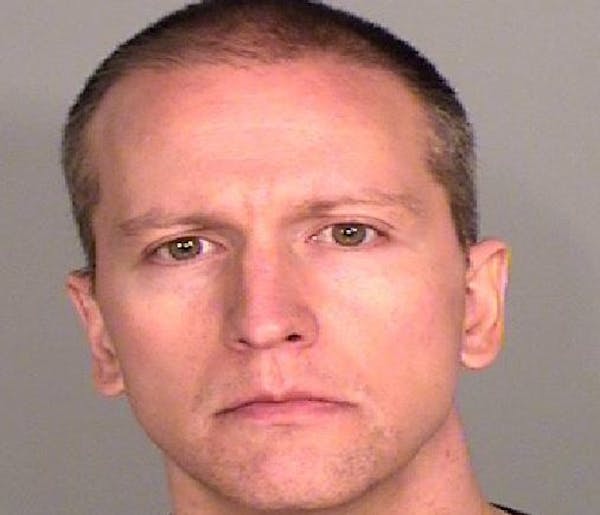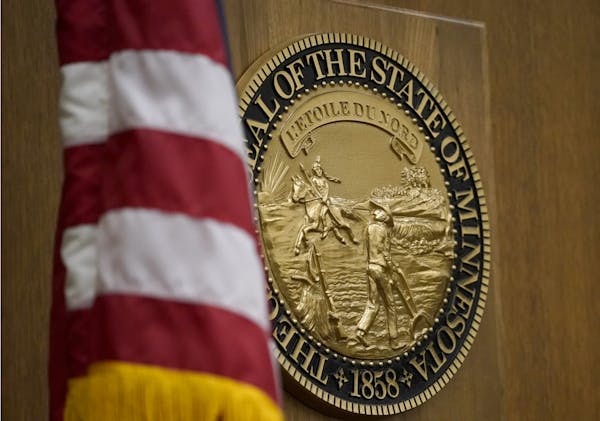Fired Minneapolis police officer Derek Chauvin did not initially tell his supervisor that he knelt on George Floyd's neck, and when he did, the ex-officer failed to report that the restraint lasted more than nine minutes as Floyd pleaded for his life, according to testimony in Hennepin County District Court on Thursday.
Recently retired supervisory Sgt. David Pleoger spoke to Chauvin on a cellphone May 25 after receiving a call from a 911 dispatcher about a possible use of force by officers seen on city surveillance cameras.
A body-worn camera captured Pleoger's initial cellphone conversation with Chauvin, who downplayed what had happened, saying, "Not really, but had to hold the guy down, he was going crazy … wouldn't go in the back of the squad."
Under questioning from prosecutor Steve Schleicher, Pleoger said Chauvin didn't say anything about putting his knee on Floyd's neck. Schleicher then pressed Pleoger on whether Chauvin's force was appropriate.
"When Mr. Floyd was no longer offering up any resistance to the officers, they could have ended their restraint," Pleoger said.
Schleicher asked if that was when Floyd was handcuffed and on the ground, Pleoger replied, "Yes."
Asked whether Chauvin initially mentioned any use of force, Pleoger said, "I don't believe so."
Pleoger was the fifth and final witness on the fourth day of testimony in Chauvin's trial on charges of second- and third-degree murder and manslaughter. He followed testimony from Floyd's former girlfriend, Courteney Ross, who tenderly recalled their initial meeting and mutual struggle with opioid addiction over a three-year stretch.
Also taking the stand were the two paramedics and a fire captain who tried to resuscitate Floyd. Derek Smith, a paramedic, checked Floyd's carotid pulse and pupils as he lay motionless under Chauvin's knee.
"I looked to my partner. I told him, 'I think he's dead and I want to move this out of here and begin care in the back [of the ambulance],' " said Smith, noting the agitated crowd of bystanders. "In a living person there should be a pulse there. I did not feel one. I suspected this patient to be dead."
Smith testified that despite never sensing a pulse, they continued trying to save Floyd. "He's a human being," Smith said. "I was trying to give him a second chance at life."
Pleoger's testimony offered the first account of Chauvin's words and behavior in the immediate aftermath of Floyd's death.
He testified that Chauvin told him that Floyd "became combative … after struggling with him. He suffered a medical emergency and an ambulance was called."
As Pleoger arrived at the scene outside Cup Foods where Floyd was restrained on suspicion of passing a counterfeit $20 bill, body camera footage captured him instructing Chauvin and officers Tou Thao, Thomas Lane and J. Alexander Kueng to speak with witnesses.
Chauvin responded, "We can try, they're all pretty hostile."
Pleoger then headed to HCMC in downtown Minneapolis to check on Floyd and instructed Chauvin and Thao to do the same. At HCMC, Pleoger said he asked Chauvin directly about the force he used.
"He said he knelt on Floyd or knelt on his neck," Pleoger testified.
Schleicher asked, "Is that the first time you became aware that force had been applied to George Floyd's neck?"
Pleoger responded, "Yes."
Schleicher asked if Chauvin told him how long he had applied the pressure. Pleoger said no.
Pleoger said he soon learned Floyd had died, so he notified internal affairs, ordered Chauvin and Thao separated and directed them to City Hall police headquarters to be interviewed. He did the same for Kueng and Lane, who were still in south Minneapolis.
In his cross-examination, defense attorney Eric Nelson continued to build on his ongoing theme about the difficulties of police decisions when faced with confrontational bystanders and safety hazards posed by passing cars and buses.
He asked Pleoger, "Would you agree with the general premise that the use of force is not necessarily attractive [and] sometimes officers have to do very violent things? It's a dangerous job."
"Yes," Pleoger replied.
Nelson asked whether it was more important for officers to deal with an encroaching crowd threat or a medical emergency. Pleoger said he would try to deal with both simultaneously.
Nelson got Pleoger to agree that giving medical aid on the spot might not be wise if there was an especially agitated crowd nearby or if a suspect were in a busy street "with buses and cars going by."
In general, the defense attorney said, officers need to assess "the totality of the circumstances and not just one single factor." The sergeant agreed with Nelson.
In the first three days of the trial, prosecutors played numerous videos from bystanders and the officers' own body cameras that showed the force used on Floyd continued for minutes after he fell silent. Thursday's testimony included much shorter video and images that showed the arrival of Hennepin EMS paramedics on the scene and in the ambulance.
Paramedic Smith and his partner Seth Bravinder testified about their efforts to revive Floyd en route to HCMC. Smith said he wanted to move Floyd quickly off the street.
Minneapolis Fire Capt. Jeremy Norton testified about meeting up with the ambulance at E. 36th Street and S. Park Avenue, where he saw Floyd being treated by the paramedics and Lane.
"He was an unresponsive body on a cot," Norton said of Floyd.
Norton said that upon his initial arrival at Cup Foods, he encountered an "agitated to distraught" off-duty firefighter, Genevieve Hansen, and other bystanders. Hansen testified Tuesday that she tried to intervene but was rebuffed by the officers. After Floyd was brought to the hospital, Norton told his supervisors at the fire department what happened.
"I was worried that a man had been killed in police custody … and then I also wanted to notify my supervisor that there was an off-duty firefighter that was a witness at the scene," Norton said.
The day's testimony started with 45-year-old Ross recalling her relationship with the strong, physically active man she called "Floyd."
Ross began sobbing as she described how she met Floyd in August 2017 while he was working security at the Salvation Army Harbor Light shelter in downtown Minneapolis. Ross said she was at the shelter to meet her son's father.
"I started fussin' in the corner of the lobby" because the father wasn't coming, she said. That's when the two met, she said, dabbing tears.
"You OK, sis?" she recalled him saying in his "great, deep Southern voice, raspy." They met again soon and had their first kiss in that lobby, she said.
She talked about their mutual oxycodone addiction that started with prescriptions for chronic pain and led to purchasing street drugs. She said they were off and on the drugs and by May she believed Floyd was using them again.
Ross also revealed that Floyd was hospitalized in March 2020 for several days because of a heroin overdose.
The defense is trying to raise the possibility that Floyd died of a drug overdose from pills obtained by Morries Hall, who was with Floyd at Cup Foods the day he died.
Ross said she and Floyd got pills in May that reminded her of "the same feeling" she had from similar pills she took in March, a stimulant that kept her up all night and left her jittery.
"And by similar experience, do you recall telling the FBI that when you had them that you felt like you were going to die?" Nelson asked. Ross said she didn't recall saying that.
Hall has filed paperwork with the court stating that he will invoke his Fifth Amendment right not to testify.
Lane, Kueng and Thao are expected to go on trial in August on charges of aiding and abetting Chauvin.
Private prison van driver, accused of raping St. Paul woman he was transporting, gets 30 years for similar attacks

Shop the curbs for free on 'Trash to Treasure Day' in White Bear Lake
Longtime Uptown boutique closing in May

Meet the Athena Award winners: 103 female athletes honored by their schools


